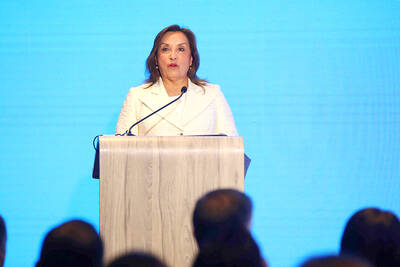Hedge funds in Asia, which navigated turbulent markets to post gains last year, had nowhere to hide last month.
As global stocks, currencies, commodities and risky bonds were roiled in a renewed frenzy of selling last month, hedge funds, including those from Quam Asset Management Ltd and Greenwoods Asset Management Ltd, fell more than 10 percent, while one from Springs Capital fell more than 20 percent.
As a group, Asia-focused hedge funds declined 3.1 percent, their worst start to a year since 2008, according to Singapore-based Eurekahedge Pte.
About 81 percent of hedge funds actively reporting to the Asia Long-Short Equities category had negative returns last month, the data show.
“January was a bloodbath to the whole world,” Chris Choy (蔡光華), chief investment officer for Quam Ltd’s (華富) China Focus Segregated Portfolio in Hong Kong, said in an e-mail.
Unless one had a “crystal ball,” it was very difficult to avoid losses, said Choy, whose US$126 million Quam China Focus fund fell 16.7 percent last month.
Hedge funds in Asia averted losses last year even as high-profile counterparts in other parts of the world were stymied amid volatile markets. That is proving to be a challenge so far this year, as fears about a global slowdown and a further decline in oil prices spurred an investor flight to safety.
The selloff wiped out more than US$7 trillion in stock market value worldwide last month, with the Shanghai Composite Index declining 23 percent and the Standard & Poor’s 500 Index sliding 5.1 percent. Oil prices slumped to a 12-year low near US$26 a barrel and losses in high-yield bonds deepened following a drop last year.
Last month was “exceptional in terms of the speed and ferocity of the declines in many markets and was in some ways reminiscent of early 2009 in the urgency of the selling,” Geoffrey Barker, who manages the Counterpoint Asian Macro Fund in Hong Kong, wrote in an investor letter.
The Counterpoint fund, which managed US$109 million as of Feb. 1, declined 3.2 percent last month, according to the letter.
Barker, a former HSBC Holdings PLC economist who manages the fund with City Financial Investment Co (Hong Kong), wrote that wrong-way bets on stocks hurt the fund and reverting to bearish wagers backfired after a rally following the unexpected cutting of interest rates by the Bank of Japan. Long positions in zinc, nickel, copper and rubber also detracted from performance.
Springs China Opportunities Fund lost nearly 24 percent last month, according to an estimate sent to investors, as the Shanghai gauge’s decline. The fund started in September 2007, when the index was trading at nearly twice its current value, and has generated a nearly 19 percent annualized return through the end of last year.
Springs is one of the few hedge funds managed outside China that focuses on the country’s domestic stock market.
Domestic class-A shares, which plunged more sharply last month than Hong Kong and US-listed Chinese shares, account for about 80 percent of investments and the stock picker uses little borrowing to enhance returns, a person with knowledge of the matter said.
Springs told investors that last month’s selloff was largely triggered by the index circuit breaker which has since been scrapped and that it sees many opportunities among A-shares, said the person, who asked not to be identified as the fund is private.
Greenwoods Asset Management’s (景林) Golden China fund, which manages more than US$1.7 billion, lost 11 percent, according to data compiled by Bloomberg. The fund, led by George Jiang (蔣錦志), was among the top performers last year. Jiang and Joseph Zeng (曾曉鬆), a partner at Greenwoods, said in an e-mail that the market volatility has given the firm plenty of investment opportunities.
“We would rather see a year started with a big correction for fundamental investors to buy on dips, rather than a year started with a big rally at the beginning and then tumbled,” Zeng said in the e-mail.
Wykeham Capital’s Asia Value Fund dropped 9.2 percent, said Howel Thomas, the firm’s Hong Kong-based portfolio manager. The fund gained 20 percent last year, bringing its annualized returns to 21 percent since its April 2009 inception, he said.
This month, the fund has gained 5.3 percent through Tuesday, paring its year-to-date decline to 4.3 percent, Thomas said.
The fund, which focuses on small-cap stocks listed in Hong Kong, received allocations from two new investors at the end of December last year, bringing its assets under management to US$25 million.
The FengHe Asia Fund, managed by F&H Fund Management Pte, fell 3.8 percent, with tumbling A-shares hurting performance, according to Rebecca Walters, the firm’s chief operating officer.
John Wu (吳炯), who was the 19th person hired by Alibaba Group Holding Ltd (阿里巴巴), started Singapore-based F&H Fund Management in 2010 with Matt Hu (胡猛), a former portfolio manager at China Securities Ltd and cofounder of Taifook Century Asset Management. FengHe Asia gained 24 percent last year.
Some funds managed to eke out gains. The Athos Asia Event Driven Fund, which had about US$146 million as of the end of last month, rose 0.08 percent last month, according to a letter to investors. The fund, led by chief investment officer Matthew Moskey and Fred Schulte-Hillen, returned 9.6 percent on an annualized basis from its inception in April 2012 through the end of December last year.
Hedge funds investing in Japan, which as a group rose last year, were also not immune to losses in January as the nation’s stocks tumbled along with those in the rest of the world. As a group, Japan-focused hedge funds declined 2.1 percent last month, according to data from Eurekahedge.
Asuka Asset Management Co’s three hedge funds are all in the red so far this year, according to Mariko Seki, who works in the US$275 million firm’s investor relations department.
Asuka Japanese Equity Long Short Strategy fell 6.1 percent last month and Asuka Opportunities Strategy slid 3.2 percent, Seki said.
Toshihiro Hirao is the portfolio manager for both funds.
Asuka Value Up Strategy, the firm’s small and mid-cap focused activist fund managed by Yosuke Mitsusada, declined 3.4 percent.

With an approval rating of just two percent, Peruvian President Dina Boluarte might be the world’s most unpopular leader, according to pollsters. Protests greeted her rise to power 29 months ago, and have marked her entire term — joined by assorted scandals, investigations, controversies and a surge in gang violence. The 63-year-old is the target of a dozen probes, including for her alleged failure to declare gifts of luxury jewels and watches, a scandal inevitably dubbed “Rolexgate.” She is also under the microscope for a two-week undeclared absence for nose surgery — which she insists was medical, not cosmetic — and is

GROWING CONCERN: Some senior Trump administration officials opposed the UAE expansion over fears that another TSMC project could jeopardize its US investment Taiwan Semiconductor Manufacturing Co (TSMC, 台積電) is evaluating building an advanced production facility in the United Arab Emirates (UAE) and has discussed the possibility with officials in US President Donald Trump’s administration, people familiar with the matter said, in a potentially major bet on the Middle East that would only come to fruition with Washington’s approval. The company has had multiple meetings in the past few months with US Special Envoy to the Middle East Steve Witkoff and officials from MGX, an influential investment vehicle overseen by the UAE president’s brother, the people said. The conversations are a continuation of talks that

CAUTIOUS RECOVERY: While the manufacturing sector returned to growth amid the US-China trade truce, firms remain wary as uncertainty clouds the outlook, the CIER said The local manufacturing sector returned to expansion last month, as the official purchasing managers’ index (PMI) rose 2.1 points to 51.0, driven by a temporary easing in US-China trade tensions, the Chung-Hua Institution for Economic Research (CIER, 中華經濟研究院) said yesterday. The PMI gauges the health of the manufacturing industry, with readings above 50 indicating expansion and those below 50 signaling contraction. “Firms are not as pessimistic as they were in April, but they remain far from optimistic,” CIER president Lien Hsien-ming (連賢明) said at a news conference. The full impact of US tariff decisions is unlikely to become clear until later this month

Nintendo Co hopes to match the runaway success of the Switch when its leveled-up new console hits shelves on Thursday, with strong early sales expected despite the gadget’s high price. Featuring a bigger screen and more processing power, the Switch 2 is an upgrade to its predecessor, which has sold 152 million units since launching in 2017 — making it the third-best-selling video game console of all time. However, despite buzz among fans and robust demand for pre-orders, headwinds for Nintendo include uncertainty over US trade tariffs and whether enough people are willing to shell out. The Switch 2 “is priced relatively high”